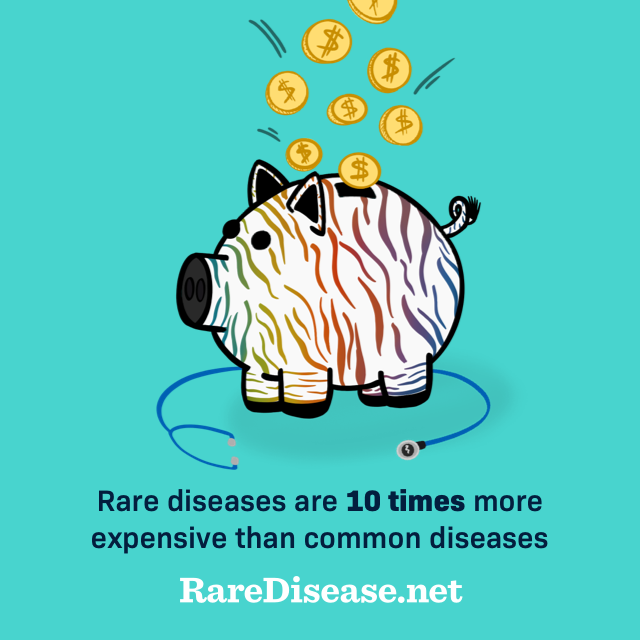Cost of Living With a Rare Disease
Reviewed by: HU Medical Review Board | Last updated: May 2025
Rare diseases are expensive. Anyone "living rare" likely knows that firsthand. Without a correct diagnosis, you may receive inappropriate care. Or you might miss a chance to prevent disease progression. Daily life is affected since rare conditions often affect multiple organs and cause life-threatening symptoms.1,2
Some people with a rare disease can go to school or work, but many cannot. This leads to lost productivity and lost income potential. With 30 million people living with one of the 7,000 known rare conditions in the United States, these costs quickly balloon.1,2
The costs extend past what a single person experiences. Rare diseases are expensive for society too. One recent study found:1
- Rare diseases are 10 times more expensive than "mass market" diseases, like diabetes and arthritis, per person per year.
- Lack of available treatments is linked to a 21.2 percent increase in total costs per person per year.
- Rare diseases cost the United States an estimated $7.2 trillion to $8.6 trillion a year.
The study also found that just 373 of the 7,000 known rare diseases cost about $2.2 trillion per year. Another study found rare conditions cost 3 to 5 times more per person per year than common health conditions.1,2
Doctors believe the numbers are even higher. This is because rare conditions can be hard to track through electronic medical records. These records are widely used by researchers to estimate things like the costs of a disease.2
Figure 2. Rare diseases are much more expensive than more common ones

Examples of rare diseases
Some rare diseases are better known than others. A few of the rare conditions you may have heard of include:1
- Fabry disease
- Gaucher disease
- Phenylketonuria
- Cystic fibrosis
- Hemophilia
- Acquired aplastic anemia
- Beta thalassemia major
- Sickle cell disease
- Juvenile idiopathic arthritis
- Myasthenia gravis
- Angelman syndrome
- Fragile X syndrome
- Amyotrophic lateral sclerosis
- Duchenne muscular dystrophy
- Inherited early-onset Alzheimer’s disease
- Spinal muscular atrophy
What makes rare diseases so expensive?
Costs for any disease falls into 3 buckets: direct costs, indirect costs, and the cost of reduced life expectancy.1
- Direct costs include:
- Prescriptions
- Devices
- Medical procedures
- Hospitalization
- Doctor visits
- Home care
- Accommodations to the home
- Other medical costs
- Indirect costs include:
- Loss of productivity for the patient and their caregivers
- Loss of work
- Travel, food, and hotels for long-distance medical visits
- Mortality costs are based on the value of a healthy life versus the life of someone with a rare disease.
If you have ever wondered, your life is worth $130,000 per year. The current average lifespan in the United States is 79 years. So based on these numbers, society on average loses $3.9 million if someone with a rare disease dies at age 49. That is the value we lose in what the person would have contributed to our world. Rare diseases cost:1
- $139,000 in direct, indirect, and mortality costs per person per year with treatment
- $240,000 in direct, indirect, and mortality costs per person per year without treatment
Other expenses linked to untreated rare conditions include:3
- Longer and more frequent hospital stays
- More treatment needed while in hospital
- Higher chance of needing home healthcare after discharge
- Higher chance of being transferred to another facility
One study found that those with rare diseases stayed an average of 6.3 days in a hospital compared to 3.8 days for people with common conditions. The difference was even more dramatic for children. A child hospitalized for a rare condition stayed 9.1 days on average compared to 2.8 days for a child with a common condition.3
Loss of productivity is almost as expensive as other costs. A person with a rare disease with no treatment loses up to $61,000 a year in lost productivity. Their caregiver loses $25,000 to $61,000 a year. These costs are reduced if there is treatment available: to up to $22,000 for the patient and $5,000 for the caregiver.1
Most rare diseases have a genetic cause and affect a few hundred to a few thousand people worldwide. But the conditions disproportionately impact children, teens, and young adults. And some conditions can severely shorten life. This is why many doctors and disease-related foundations want more research. They would like to see earlier, more accurate diagnosis and more treatments approved by the US Food and Drug Administration.4
